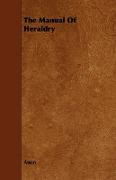- Start
- The Manual of Heraldry
The Manual of Heraldry
Angebote / Angebote:
powdered wigs and hooped petticoats of the last century have not gone out of fashion alone. With those monstrous absurdities of costume we have lost the most of the modes of building and styles of furniture and decoration which formed part of the taste of the time of the Georges. Chinese pagodas, pug dogs, patches, six-inch heels, have happily for our reputation passed away in company. In place of all these half French, half German exotios, the people of England are now again inclined to revert to the more substantial, more real, more comfortable taste of the days before old halls and bay windows had given way to Gallicized saloons-to the days of English hospitality and enjoyment, when the mansion of the country gentleman was reared of solid stone and English oak, instead of Roman cement and American deals. The comfort of a wainscotted chamber is once more recognised and as a natural - consequence of this healthy reaction in the mdte of the country, the ancient decoration of ume- honoured houses have again become interesting, and once more a favourite study. Under these circumstances the following Volume is submitted to the reader, in the confident hope that its accuracy, as an ILLUSTRATED of HERALDRY, will secure his approbation. In its pages will be found all the varied figures invented by the College of Heralds, and bestowed from the day of the Conquest to the reign of Elizabeth upon the nobility and gentry as marks of merit for services rendered in the cabinet or in the field. These emblazonments, it is scarcely necessary to remark, were so highly prized as to form the chief ornament not only of the habiliments of all persons of rank but of the halls, the palaces, and even the churches of our country, during many centuries of her history. The constant reference to heraldic bearings in works intended for the antiquary, the architect, and the artist, and the frequent allusion to them in volumes perused by all classes, induces the Editor to believe this manual will be found of very great service to the student as well as the general reader. Although in this little volume it was neither deeirable nor practicable to enter upon an elaborate criticism, or much research into curious and obsolete terms and usages, yet nothing is omitted likely to form a subject of inquiry in reference to the Armorial Bearings of the nobility and gentry of Great Britain is the science which teaches how to blazon or describe in proper terms armorial bearings and their accessories. Many volumes have been written on the origin of Heraldry and even on the antiquity of separate charges contained in an escutcheon it would be filling the pages of an elementary work on Heraldry to little purpose to enter upon an inquiry as to the exact period of the introduction of all art that has existed in some degree in all countries whose inhabitants have emerged from barbarism to civilization. In all ages men have made use of figures of living creatures, trees, flowers, and inanimate objects, as symbolical signs to distinguish themselves in war, or denote the bravery and courage of their chief or nation. The allegorical designs emblazoned on the standards, shields, and armour of the Greeks and Romans- the White Horse of the Saxons, the Raven of the Danes, and the Lion of the Normans, may all be termed heraldic devices but according to the opinions df Camden, Spelman, and other high authorities, hereditary atms of families were first introduced at the commencement of the twelfth century...
Folgt in ca. 10 Arbeitstagen
